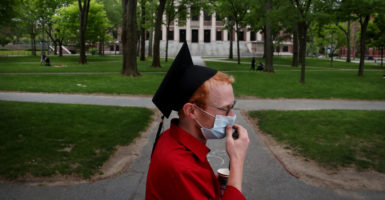July is typically a busy month for State Department consular officers around the world interviewing student visa applicants as many foreign students seek to travel to the U.S. to begin their academic year in August.
As with many other aspects of our lives, however, COVID-19 is wreaking havoc upon both the new academic year and the visa process for foreign students.
The Department of Homeland Security on Monday announced, at the request of the State Department, that if colleges and universities offer no in-person classes for students during the fall semester, the State Department would not issue visas to foreign students abroad, and that those students already in the U.S. should seek to take other measures, such as transferring schools or leave the U.S. for the fall semester.
>>> What’s the best way for America to reopen and return to business? The National Coronavirus Recovery Commission, a project of The Heritage Foundation, assembled America’s top thinkers to figure that out. So far, it has made more than 260 recommendations. Learn more here.
This policy announcement continues to provide flexible visa regulation requirements for foreign students to study in the U.S. in the new academic year, albeit in a more limited fashion than the Department of Homeland Security offered in March to complete the 2019-2020 academic year.
The foreign student visa regulation before the COVID-19 pandemic states that an academic student can enroll in classes “for credit or classroom hours, no more than the equivalent of one class or three credits per session, term, semester, trimester, or quarter [to] be counted toward the full course of study requirement if the class is taken online or through distance education and does not require the student’s physical attendance for classes, examination or other purposes integral to completion of the class.”
That limitation was put in place to combat fraud by organizations offering fake courses of study online.
When COVID-19 halted normal life in the middle of the spring semester, the Department of Homeland Security announced a very flexible policy for foreign students to maintain student status for immigration purposes as schools adapted to online instruction (or even no instruction) in excess of the regulatory one-class/three-credit online limit.
The guidance stated the temporary allowance was “in effect only for the duration of the emergency” and that the “guidance may be subject to change.” This policy continues through the current summer semester. Such flexibility made sense to allow students to complete the academic year.
This week’s announcement does not return to the one-class/three-credit limit for online instruction in the fall semester, but it does require some in-person instruction in the new academic year.
Specifically, the new policy guidance states that “[s]tudents attending schools operating entirely online may not take a full online course load and remain in the United States. … [S]tudents attending schools adopting a hybrid model—that is, a mixture of online and in-person classes—will be allowed to take more than one class or three credit hours online.”
Schools from pre-kindergarten through college have struggled with decisions and planning for the new academic year.
While the Centers for Disease Control and Prevention has provided more risk-averse guidance to resume in-person teaching, other organizations, such as the American Academy of Pediatrics, have been more forward-leaning in getting students back into real classrooms.
President Donald Trump agrees with the latter approach and may have approved this revised foreign student visa policy to help achieve that end. He tweeted “SCHOOLS MUST OPEN IN THE FALL!!!” the same day as the fall 2020 Department of Homeland Security announcement.
The real effect of this new policy announcement will be upon those foreign students located abroad. The Department of Homeland Security announcement reads that the State Department “will not issue visas to students enrolled in schools and/or programs that are fully online for the fall semester, nor will U.S. Customs and Border Protection permit these students to enter the United States.”
For those foreign students already in the U.S. and enrolled in online courses only, the Department of Homeland Security announcement instructs them to “depart the country or take other measures, such as transferring to a school with in-person instruction to remain in lawful status or potentially face immigration consequences,” including the initiation of removal proceedings.
As a practical matter, the in-country student guidance is difficult to implement for a number of reasons. Students wouldn’t have sufficient time to transfer schools before the academic year begins.
In addition, Immigration and Customs Enforcement does not have the resources to prioritize searching for students enrolled in a full-time online course load. Further, removal proceedings take years—far longer than the fall semester, or even academic year, during which online-only students would be violating their immigration status per this guidance.
Colleges and universities have a choice to offer at least partial in-person teaching this many months after the COVID-19 outbreak and the nation’s compliance with earlier stay-at-home orders.
Likewise, academic institutions certified to participate in the Department of Homeland Security and State Department foreign student program know the course requirements such students must meet to remain in lawful immigration status.
If schools decide to offer no in-person classes in the new academic year, it’s reasonable for the State Department to not issue visas to applicants seeking to come to the U.S. to be an online-only student. It’s unprecedented, but so is this COVID-19 era.
Hopefully, colleges and universities will not follow Harvard’s lead in offering only online courses for the 2020-2021 academic year, at a tuition cost of $50,000 for the school year.
Academic institutions can be creative, just as businesses have had to be, in offering some small, in-person classes while maintaining social distance among students and the professors. Offering at least a hybrid caseload is a low health risk option for young college students that helps advance their education and returns their lives to some needed normalcy.

























